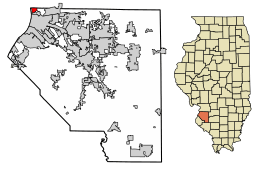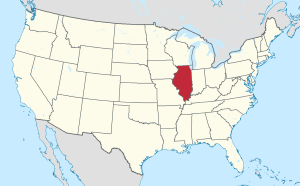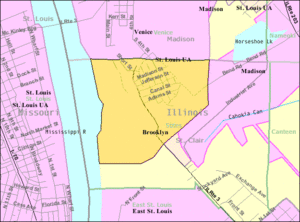Brooklyn, Illinois facts for kids
Quick facts for kids
Brooklyn
|
|
|---|---|

Brooklyn in St. Clair County, Illinois.
|
|

Location of Illinois in the United States
|
|
| Country | United States |
| State | Illinois |
| County | St. Clair |
| Founded by | traditionally said to be Priscilla Baltimore |
| Area | |
| • Total | 0.81 sq mi (2.10 km2) |
| • Land | 0.81 sq mi (2.10 km2) |
| • Water | 0.00 sq mi (0.00 km2) |
| Elevation | 410 ft (120 m) |
| Population
(2020)
|
|
| • Total | 649 |
| • Density | 800.25/sq mi (308.89/km2) |
| Time zone | UTC-6 (CST) |
| • Summer (DST) | UTC-5 (CDT) |
| ZIP Code(s) |
62059
|
| Area code(s) | 618 |
| FIPS code | 17-08667 |
| GNIS feature ID | 2397466 |
| Wikimedia Commons | Brooklyn, Illinois |
Brooklyn (also known as Lovejoy) is a village in St. Clair County, Illinois, United States. It is located just north of East St. Louis, Illinois and northeast of downtown St. Louis, Missouri. Brooklyn is special because it is one of the oldest known communities in the United States founded by Black people. Its motto is "Founded by Chance, Sustained by Courage." The current mayor is Vera Banks-Glasper.
An early church, Quinn's Chapel AME, was started in Brooklyn in 1836. Its members, along with those from Antioch Baptist Church (established in 1838), are believed to have helped people escape slavery through the Underground Railroad. This was a secret network of safe houses and routes.
Even though it was an early community where different races lived together, Brooklyn faced challenges. For example, transportation lines were built to go around it, making it harder for the village to connect with other places. Economic projects often skipped Brooklyn, which made it difficult for the community to grow.
Contents
History of Brooklyn
The story of Brooklyn began around 1829. A brave woman named "Mother" Priscilla Baltimore led a group of eleven families to freedom. These families included both people who had escaped slavery and those who were already free. They left St. Louis, Missouri, and crossed the Mississippi River into Illinois, which was a free state. There, they started a new community.
Priscilla Baltimore was said to have bought her own freedom and the freedom of her family members. She was born in Kentucky and later found her white father in Missouri to buy her mother's freedom. Early Black families in Brooklyn included names like Anderson, Sullivan, Singleton, Wilson, Cox, Wyatt, and Carper.
Historians have found written records showing that Priscilla Baltimore was in St. Louis in the 1830s. The first time she is mentioned with Brooklyn is in 1839. She might have traveled between the two places for a while.
Priscilla Baltimore became a Methodist preacher and was very involved in the religious life of the new settlement. In 1836, William Paul Quinn, a missionary for the new African Methodist Episcopal Church (AME), visited the community. He helped start the Brooklyn AME church that year. This church, now called Quinn's Chapel AME Church, is thought to be the first AME Church west of the Appalachian Mountains. William Paul Quinn later became an important leader in the AME Church.
In 1837, five white abolitionists (people who wanted to end slavery) helped plan the town. One of them, Thomas Osburn, lived in the area for many years. Priscilla Baltimore built her house on his former land and lived there from 1851 to 1872. By the 1840s and 1850s, about 200 African Americans lived in the village.
From the very beginning, the ministers of Quinn Chapel AME Church and Antioch Baptist Church (started in 1838) used their churches as stations for the Underground Railroad. They helped enslaved people escape to freedom, sometimes even as far as Canada. William Paul Quinn and Priscilla Baltimore would visit nearby towns to tell enslaved people about the Underground Railroad. They would hide people in the churches before sending them to the next safe place. Both of these historic church buildings are still standing today.
On July 8, 1873, Brooklyn officially became an incorporated village. By 1880, it had 371 African-American residents and 203 European-American residents. In the late 1800s, people in Brooklyn started working in new industrial jobs in nearby East St. Louis. Many Black people moved to Brooklyn because they wanted to live in a community where they could have more control over their own lives. In 1886, the African-American majority worked together to register voters and gained political control of the village.
However, major investments like railroad connections often went to other towns, especially East St. Louis, Illinois. This made it harder for Brooklyn to grow economically. Over time, the village became almost entirely Black.
In 1891, the mayor at the time, Mayor Evans, named the town's new post office "Lovejoy." This was in honor of Elijah P. Lovejoy, an abolitionist who was killed in Alton, Illinois, in 1837. The high school in Brooklyn was also named after him. Around the early 1900s, the high school was very well-known in the area.
Brooklyn in the 20th Century
Even with its independence, Brooklyn faced challenges. As industries declined in the mid-20th century, jobs became scarce. This led to high unemployment and other problems, similar to those faced by nearby East St. Louis.
Exploring Brooklyn's Past
Before a new bridge was built between St. Louis and Illinois, archaeologists had to survey the land near Brooklyn. In 2002, they found many ancient artifacts! There were so many that they named the site "Janey B. Goode" after a famous song. This site is within Brooklyn's limits and shows that people lived there long ago, possibly between 600 AD and 1200 AD. This discovery suggests that a large and complex community of Native Americans once lived in the area.
Archaeologists also worked with the village of Brooklyn to explore its early 19th-century history. They found signs of early African-American life from the 1830s to the 1870s. This means that the remains of Mother Baltimore's original "Freedom Village" might still be hidden underground in Upper Brooklyn. Finding more evidence could make the town even more historically important.
Since the early 2000s, residents have been very active in learning and sharing their village's history. They have collected stories from older residents. In 2007, they started the Historical Society Of Brooklyn, Illinois. This group works with archaeologists and museums to protect Brooklyn's history.
The Historical Society also helped find "Mother" Priscilla Baltimore's unmarked grave in St. Louis. In September 2010, they placed a special gravestone there to honor her. They are also working to survey Brooklyn's own cemetery to find and document old graves.
Surveys in 2008 showed that Brooklyn's historical records are still mostly untouched beneath the ground. In 2009, an archaeological study began to dig into Mother Priscilla Baltimore's freedom village. The goal is to find enough evidence to get Brooklyn listed on the National Register of Historic Places. This would officially recognize its important history. In 2023, Brooklyn was added to a list of "Most Endangered Historic Places in Illinois." This highlights the need to protect its history and help the community grow.
The Historical Society and its partners are trying to get three important sites officially recognized:
- The ancient Janey B. Goode archaeological site.
- Brooklyn's historic cemetery.
- Quinn Chapel A.M.E. Church, built in 1836. This church was the first of its kind (African Methodist Episcopal Church) built west of the Appalachian Mountains and the first in Illinois.
Geography
Brooklyn, Illinois, is located at 38°39′24″N 90°09′55″W / 38.656800°N 90.165412°W.
According to the 2010 census, Brooklyn covers a total area of about 0.83 square miles (2.1 square kilometers), all of which is land.
Population Information
| Historical population | |||
|---|---|---|---|
| Census | Pop. | %± | |
| 1900 | 1,019 | — | |
| 1910 | 1,569 | 54.0% | |
| 1920 | 1,685 | 7.4% | |
| 1930 | 2,063 | 22.4% | |
| 1940 | 2,158 | 4.6% | |
| 1950 | 2,568 | 19.0% | |
| 1960 | 1,922 | −25.2% | |
| 1970 | 1,702 | −11.4% | |
| 1980 | 1,233 | −27.6% | |
| 1990 | 1,144 | −7.2% | |
| 2000 | 676 | −40.9% | |
| 2010 | 749 | 10.8% | |
| 2020 | 649 | −13.4% | |
| U.S. Decennial Census | |||
| Race / Ethnicity (NH = Non-Hispanic) | Pop 2000 | Pop 2010 | Pop 2020 | % 2000 | % 2010 | % 2020 |
|---|---|---|---|---|---|---|
| White alone (NH) | 4 | 17 | 15 | 0.59% | 2.27% | 2.31% |
| Black or African American alone (NH) | 664 | 703 | 604 | 98.22% | 93.86% | 93.07% |
| Native American or Alaska Native alone (NH) | 1 | 0 | 2 | 0.15% | 0.00% | 0.31% |
| Asian alone (NH) | 0 | 0 | 0 | 0.00% | 0.00% | 0.00% |
| Pacific Islander alone (NH) | 0 | 0 | 0 | 0.00% | 0.00% | 0.00% |
| Other race alone (NH) | 0 | 2 | 1 | 0.00% | 0.27% | 0.15% |
| Mixed race or Multiracial (NH) | 4 | 15 | 16 | 0.59% | 2.00% | 2.47% |
| Hispanic or Latino (any race) | 3 | 12 | 11 | 0.44% | 1.60% | 1.69% |
| Total | 676 | 749 | 649 | 100.00% | 100.00% | 100.00% |
As of the census in 2000, there were 676 people living in Brooklyn. Most of the residents were African American. By 2020, the population was 649 people.
Education
Brooklyn Unit School District 188 runs the public schools in the village.
Notable People
- Hamiet Bluiett, a famous saxophonist (1940–2018)
- Prince Joe Henry, a Negro league baseball player
- Albert King, a well-known blues guitarist (1923–1992)
Images for kids
See also
 In Spanish: Brooklyn (Illinois) para niños
In Spanish: Brooklyn (Illinois) para niños



